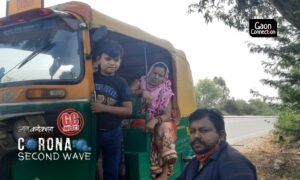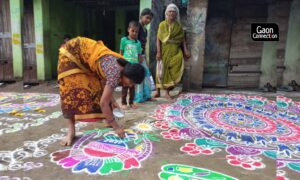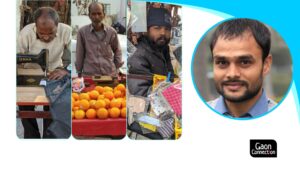Ajrakhpur, a tiny village near Bhuj in Gujarat, over 300-km from the state capital Ahmedabad, is prominent on the maps of designers, design schools and artists across the world. The village derives its name from the art of Ajrakh — block printing using natural dyes derived from indigo, henna, turmeric, pomegranate, iron and mud. Families of Ajrakh artisans inhabit this village.
In the past, several shopping portals and traders approached Sufiyan Khatri, a ninth-generation Ajrakh craftsman and resident of Ajrakhpur to put up his products online for sale. But, he never warmed up to the idea. “Back then, I was not very keen on the online medium. Other artisans also did not think such a move was required,” Sufiyan told Gaon Connection. “But, the lockdown has hit all the artisans very bad and our business is down. We are finally taking help of the internet to market and sell our products. That is the only way to survive,” he added.
This thought is echoed not just by the craftspeople of Ajrakhpur, but by several other artisans in the Kachchh region of Gujarat who are into weaving, embroidery, bell metal craft, leather work, Rogan art, etc. Usually reticent and happy in their workshops, they are now adapting to the changing times by creating social media accounts on Facebook and Instagram, launching their own websites, organising and participating in online exhibitions, and approaching clients through these new mediums. And, their efforts are bearing fruits as sales are picking up.
A new journey into the virtual world
Sufiyan has created an account on Etsy, an online shopping portal, whose speciality is handcrafted items. He has also activated his dormant Instagram account and updated his website created last year. Incidentally, he received his first online order on March 25, the first day of the nationwide lockdown, from a client in Italy, which initially was one of the worst-affected countries by the coronavirus disease (COVID-19) pandemic. In the last three months of the lockdown, he has also received orders from the UK and the US, all of which have been shipped.
Khalid Amin Khatri, another young Ajrakh craftsman from the same village, has also entered the virtual world and sold 10 sarees, 26 stoles, and 30 metres fabric through online shopping portals in the lockdown period. Specialising in contemporary, abstract art form in the traditional Ajrakh style, Khalid informed he sold his products to clients in Allahabad, Delhi, Ahmedabad, Hyderabad, and other cities in the country.
“I send them [potential customers] pictures of my products on a special WhatsApp group. Whatever clients select, I courier it to them,” he said.
Challenges on the way
Although the sales are slowly picking up, the losses suffered by the artisans during the lockdown are huge. These online sales are only helping them keep their head above water.
“In the last three months I have sold products worth Rs 25 lakhs,” informed Sufiyan. Seemingly a big amount, it is still a downsized business, as Sufiyan’s family is one of the most prominent ones in Ajrakhpur and supports at least 200 workers and their families. With the lockdown and its economic implications, half of his his workforce has stayed away from work and wages.
“The domestic market has been slow. A lot of orders from some of our major clients were cancelled and no new orders have been placed,” he lamented.
Vankar Meghji Harji, president of the Weavers Association told Gaon Connection the bulk orders from some of the well-known brands typically come in June-July and have already been cancelled. “We tried telling them not to cancel the orders, but they informed their pre-existing stocks were still lying around and showrooms were either closed or had very few customers,” he said.
A saving grace for most craftspeople has been the timing of the pandemic. Padmashree Abdul Gafur Khatri of Kachchh’s Nirona village told Gaon Connection the lockdown had coincided with “off-season” for the Rogan art.
“Most of our work and client visits happen between September and March. However, this year we had our calendar chock-a-block in April — all of which were cancelled,” he said. “We haven’t been able to conduct classes, or go for exhibitions. And all that has affected business a lot,” he added.
Abdul Gafur’s is the only remaining family that still practices Rogan art, which reflects the artist’s imagination on a piece of cloth as he swirls a spool of naturally prepared paint over it without any tracing. Once complete, the artwork looks fine as needlework.
Uniqueness lost in the virtual world
The intricate detailing of every craft—the process behind, the single-minded focus with which every artist works on an art piece — which finally makes handcrafted items like a piece of Rogan art, or an Ajrakh saree is unique. But, this uniqueness is lost in the online medium. Artisans like Sufiyan or Abdul Gafur are struggling to communicate to potential customers the value of each piece of their art work over the internet.
“The colour you see online may not be exactly the same when it is in your hand and that’s because it’s a natural dye,” Ghatit Lehru of Khamir, a non-profit working with the craftspeople in Kachchh told Gaon Connection. “There have been many instances where people returned those products. And, it becomes a problem for small artisans,” he added.
Moreover, different online shopping portals have different rules — some ask for ample stock to keep in their warehouse, others put the onus on the artisans to ship the products. “In the present scenario, where some places have been identified as COVID-19 containment zones, transportation is a challenge. What would normally take three-four days to reach a place, now takes 12-15 days,” said Lehru. Artisans have their art but not necessarily the resources or the infrastructure to sell it, he lamented.
To address these challenges, five organisations have come together to form the Kachchh Craft Collective to make the products available online to the buyers. Their first investment would be on warehousing.
Adapt and survive
Weavers, however, are not sitting idle. “Some of the weavers have started marketing their produce online and have managed to even sell some pieces,” said Harji. “Others are continuing to work with purana dhaga (old yarn) in anticipation of things looking up towards the end of the year and expecting people to visit and dhurries, shawls, and stoles,” he added.
Artisans are also increasingly exploring the idea of organising and participating in online exhibitions. Mohammad Jabbar Khatri, the 27-year-old nephew of Abdul Gafur Khatri, is also a Rogan artist and has organised two such exhibitions. Recently, he was invited by the National Institute of Interior and Fashion Designing for a live session on Instagram on the Rogan art.
“It’s been a month since we came on the Instagram. We are on Facebook, and have created our own website, too. We are receiving enquiries on our products,” Jabbar told Gaon Connection.
Some craftspeople have also written to the state government, urging it to buy their products so that they can re-invest the money into preparation for the next season. “Crafts like tie and dye, or weaving, still stand a chance in the regular market. But, some other art forms, like Rogan, leather work, lacquer, bell metal are facing very difficult times. Customers like to see these products and understand the process behind them before placing their orders,” said Abdul Gafur.
Artisans desperately need a corpus to re-invest in the next season’s ware, but are wary of taking any loan. They don’t want to fall into the debt trap.
“Jitna tak ho sake hum khud kuch karenge [We will strive to work on our own until it’s feasible],” 27-year-old Khalid, an Ajrakh craftsman told Gaon Connection. His father, Amin Khatri, in his fifties, has already graduated to a smart phone to learn nuances of social media and selling products online.



















